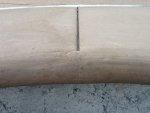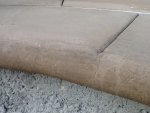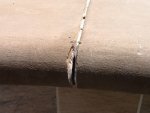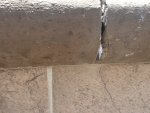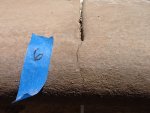Should we worry about these cracks on the faces of the coping when control joints are only on top? We have about ten cracks so far which represents roughly 40 percent of the coping control joints. Can this be repaired or is it an issue with how they mixed concrete? Will there be bigger problems down the road? Seems like they will only get allot worse. Also coping color doesn't match decking.
Two day old coping and it is cracking already
- Thread starter Lmiso
- Start date
You are using an out of date browser. It may not display this or other websites correctly.
You should upgrade or use an alternative browser.
You should upgrade or use an alternative browser.
I know those types of cracks are common with cantilever coping but 2 days does seem a little soon. I'm having mine poured next week. I'll let you know if I experience the same thing.
Were you on site when the concrete was poured? If you were, how wet or dry was the mix? If very wet, almost soup-like, you can expect many microcracks. When it was poured, would the concrete "stack up" as it came out of the chute or did it "flow" a long distance?
When pouring concrete, it is best to wet it only as much as you need for workability. It takes more effort to work a dry mix, but the results are worth it. Wet mixes also tend to have color variations between pours, even with the same mix of concrete/coloring agent. Using a vibrator on dry mixes helps with the smoothing process, and removes any air bubbles in the finish.
The cracks you picture may not actually be any deeper than 1/4 - 1/2", but could be deeper. I'd be asking you PB about replacement. You will have a hard time keeping the coping sealed.
When pouring concrete, it is best to wet it only as much as you need for workability. It takes more effort to work a dry mix, but the results are worth it. Wet mixes also tend to have color variations between pours, even with the same mix of concrete/coloring agent. Using a vibrator on dry mixes helps with the smoothing process, and removes any air bubbles in the finish.
The cracks you picture may not actually be any deeper than 1/4 - 1/2", but could be deeper. I'd be asking you PB about replacement. You will have a hard time keeping the coping sealed.
Charlie, unfortunately I did not witness the pour, I wondering if they did replace coping how they would get it out with damaging the integrity of the pool, ie jackhammers or sledgehammers
Mass nerd, I am looking forward to seeing your pool pics
Mass nerd, I am looking forward to seeing your pool pics
My brother-in-law had his cantilever crack within first month in same spot. PB came out and cut the expansion joint down around the curve and it solved the problem. All the hair line cracks were at the expansion joint above on the deck.
Is there a reason why the control joints are only on the top? My cantilever coping has it going down the edges. My coping was poured almost 2 months ago and I don't see any cracking as of yet. Then again it's hard to tell because ours is also stamped (mistake by the concrete guys :grrrr but those cracks would bother me as well.
but those cracks would bother me as well.
My Pour in place coping was done a few months ago but the control joints go around the curve. I still have "micro cracks" here and there like yours.
Like you, I was at work when they did the coping so didn't witness their method.
Like you, I was at work when they did the coping so didn't witness their method.
There is no such thing as crack free concrete - if there was, I would be rich.. It cracked at the weak point and I agree with others that the control joint should have been extended, but then you would only have a crack at that area.
What is the best solution?
1. Leave cracks and ask for discount? (How much?)
2. Cut control joints with a diamond blade? ( possible risk of coping crumbling because cracks are not straight)
3. Tear out and redo on PB dollar?
4. ??
1. Leave cracks and ask for discount? (How much?)
2. Cut control joints with a diamond blade? ( possible risk of coping crumbling because cracks are not straight)
3. Tear out and redo on PB dollar?
4. ??
Any concrete work I have ever done for people comes with this disclaimer...I can guarantee two things will happen. Concrete will get hard and it will crack. The only thing I see"wrong" here is that they did not extend the joint around the edge of the coping. If you look you will see that the crack extends all the way thru the beauty joint already. I don't know if there is much you can ask for. With or without the beauty joint the cracks would have developed at some time.Lmiso said:What is the best solution?
1. Leave cracks and ask for discount? (How much?)
You could do this, but the control joint is already established now. It is posible to take a small grinder and feather the edges to prevent any chipping. your PB may agree to this. The cracks appeared due to one thing. Shrinkage induced stress. When water evaporated out of the mix the edges tend to shrink some putting stress on the mass. Eventually the stress has to relieve and since concrete is a horible material when in tension, cracks happen. This is why it is important to seal the concrete as soon as posible after the pour to prevent the water evaporation.Lmiso said:2. Cut control joints with a diamond blade? ( possible risk of coping crumbling because cracks are not straight)
All I can say here is "good Luck"Lmiso said:3. Tear out and redo on PB dollar?
Lmiso said:What is the best solution?
1. Leave cracks and ask for discount? (How much?)
2. Cut control joints with a diamond blade? ( possible risk of coping crumbling because cracks are not straight)
3. Tear out and redo on PB dollar?
4. ??
What ever you do, do not patch it. The good news is that your concrete is "normal"
If you look at control joints (everywhere) sidewalks, etc, that is where they are normally cracked - they are there for that reason.
I would discuss a cosmetic solution to the portion that they did not install correctly. As noted by others, any grinding may cause it to spall more and make look worse.
- Sep 15, 2012
- 25
danpik said:...The cracks appeared due to one thing. Shrinkage induced stress. When water evaporated out of the mix the edges tend to shrink some putting stress on the mass. Eventually the stress has to relieve and since concrete is a horible material when in tension, cracks happen. This is why it is important to seal the concrete as soon as posible after the pour to prevent the water evaporation...
Would you please explain what "sealing the concrete" means?
I been told to try to keep the exposed concrete surfaces moist with water over the first 72 hours, to reduce the rate of evaporation and to remove heat generated in the curing process.
ignoramous said:danpik said:...The cracks appeared due to one thing. Shrinkage induced stress. When water evaporated out of the mix the edges tend to shrink some putting stress on the mass. Eventually the stress has to relieve and since concrete is a horible material when in tension, cracks happen. This is why it is important to seal the concrete as soon as posible after the pour to prevent the water evaporation...
Would you please explain what "sealing the concrete" means?
I been told to try to keep the exposed concrete surfaces moist with water over the first 72 hours, to reduce the rate of evaporation and to remove heat generated in the curing process.
From a design perspective, concrete is a porous product (sand, rock, cement, and water) and regardless what you do, it will crack. You can apply what ever seal you want and it will crack later. The goal is to attempt to mitigate the cracks and migration of water so that you do not structurally damage the substrate (e.g. erosion) and for the purposes of pools - loose water. Assuming they used a water proof "mortar" under the coping, the latter is unlikely. My opinion, you are dealing with a cosmetic item. These types of items tend to have a worse fix, then negotiations or other remedies previously outlined.
Disclaimer: I am not a pool builder or concrete installer, but I have dealt with the latter and owners way too long.
[quote="ignoramous
Would you please explain what "sealing the concrete" means?
I been told to try to keep the exposed concrete surfaces moist with water over the first 72 hours, to reduce the rate of evaporation and to remove heat generated in the curing process.[/quote]
Concrete cures by a chemical reaction. This "exothermic" reaction produces heat to cure the elements of the mix into one solid mass. Concrete does not "dry" as it is often refered to. all of the water that was added to the mix at the plant should be present in the mix when cured. If water evaporates out of the mix during this cure process then the strength of the mix is diminished somewhat. also, any evaporation causes loss of mass in the area it evaporates from which causes shrinkage, which induces stress. Most concrete installers recomend keeping the pour wet as yours did. This will, as they said, keep the evaporation in check. However, if the surface dries out, the wetting process may as well be over.
When we pour concrete, we put a concrete sealer on it as soon as the "sheen" is gone. That sheen is the excess water that has migrated to the surface during the finishing. Usually less than an hour after we have done the last of the finishing is when we spray the sealer. This forms a waterproof membrane on the surface that stops all evaporation. I have done driveways for people that stayed green for up to two weeks when doing this. I routinly have to explain to the customer that this is normal for my jobs and it will, over a 2-3 week period, slowly turn to the light grey the are accustomed to seeing.
The apron of my driveway and my neighbors driveway are a good studdy in why proper curing is essential for concrete. I did my apron about 10 years ago. and it is still in excellent condition. This, mind you, is in an area where the roads are paved in rock salt all winter. My neighbors driveway, done a couple years later, is all spalled on the surface and is full of cracks. The idiot contractor told him not to waste any money on a sealer and just let it dry out. This caused a lot of surface evaporation which weakened the surface layer. (I also suspect they did not finish it properly and just did a quick float and broom job on it) They also did not put in any control joints in a timely manner. Instead, they cut them in almost a month later. Look at it now and there is not one crack in the control joints but there are several throuout the surface of the drive.
Would you please explain what "sealing the concrete" means?
I been told to try to keep the exposed concrete surfaces moist with water over the first 72 hours, to reduce the rate of evaporation and to remove heat generated in the curing process.[/quote]
Concrete cures by a chemical reaction. This "exothermic" reaction produces heat to cure the elements of the mix into one solid mass. Concrete does not "dry" as it is often refered to. all of the water that was added to the mix at the plant should be present in the mix when cured. If water evaporates out of the mix during this cure process then the strength of the mix is diminished somewhat. also, any evaporation causes loss of mass in the area it evaporates from which causes shrinkage, which induces stress. Most concrete installers recomend keeping the pour wet as yours did. This will, as they said, keep the evaporation in check. However, if the surface dries out, the wetting process may as well be over.
When we pour concrete, we put a concrete sealer on it as soon as the "sheen" is gone. That sheen is the excess water that has migrated to the surface during the finishing. Usually less than an hour after we have done the last of the finishing is when we spray the sealer. This forms a waterproof membrane on the surface that stops all evaporation. I have done driveways for people that stayed green for up to two weeks when doing this. I routinly have to explain to the customer that this is normal for my jobs and it will, over a 2-3 week period, slowly turn to the light grey the are accustomed to seeing.
The apron of my driveway and my neighbors driveway are a good studdy in why proper curing is essential for concrete. I did my apron about 10 years ago. and it is still in excellent condition. This, mind you, is in an area where the roads are paved in rock salt all winter. My neighbors driveway, done a couple years later, is all spalled on the surface and is full of cracks. The idiot contractor told him not to waste any money on a sealer and just let it dry out. This caused a lot of surface evaporation which weakened the surface layer. (I also suspect they did not finish it properly and just did a quick float and broom job on it) They also did not put in any control joints in a timely manner. Instead, they cut them in almost a month later. Look at it now and there is not one crack in the control joints but there are several throuout the surface of the drive.
PB came out and starting cutting control joints in the lip of the coping, sure as sh&t it starting crumbling. He said this is how he always does it and it just has to be patched now. I am very skeptical.
- Sep 15, 2012
- 25
danpik:
Thanks for the explanation about sealing concrete. That's the first I've heard of using a sealer during curing to limit evaporation.
Thanks for the explanation about sealing concrete. That's the first I've heard of using a sealer during curing to limit evaporation.
Kwikee
0
There is a different between sealer and curing compound. Curing agents are applied while the concrete is uncured, to retain moisture and prevent the surface dehydrating and therefore hardening faster than the underlying concrete, which causes cracking. One of the common ones is a latex based liquid which seals the surface temporarily, breaks down in UV light and disappears in a few days. Sealer is applied at least several days, if not weeks, after the concrete is poured, and is used to enhance the appearance of the concrete, prevent staining and to try to keep the colour as uniform as possible under wear and tear.
As for the cracks, they have occurred exactly where they were intended and as others have said, the tooled joint probably should have extended around the lip. In saying that, the crack would still occur so there is no structural or functional failure, purely aesthetic, and even then minor. I doubt it will get any worse, and I think you'll find in time you will barely notice them.
Where they have saw cut, did they use a continuous rim blade, or a segmented blade? Continuous rim will cause a lot less spalling along the cut. If you really need it fixed, it could be caulked with a coloured urethane caulk.
FWIW, I am a structural foreman with a concrete/formwork company in Australia.
As for the cracks, they have occurred exactly where they were intended and as others have said, the tooled joint probably should have extended around the lip. In saying that, the crack would still occur so there is no structural or functional failure, purely aesthetic, and even then minor. I doubt it will get any worse, and I think you'll find in time you will barely notice them.
Where they have saw cut, did they use a continuous rim blade, or a segmented blade? Continuous rim will cause a lot less spalling along the cut. If you really need it fixed, it could be caulked with a coloured urethane caulk.
FWIW, I am a structural foreman with a concrete/formwork company in Australia.
Thread Status
Hello , This thread has been inactive for over 60 days. New postings here are unlikely to be seen or responded to by other members. For better visibility, consider Starting A New Thread.


